Fires in commercial buildings can be devastating causing loss of fire property damage and business interruptions. Understanding the most common fire hazards and taking preventive measures can help you protect your employees, customers and assets. In this guide you can check out five common fire hazards in commercial buildings and how to prevent them.
Electrical malfunctions
Electrical fires are one of the leading causes of commercial building fires. They basically happen when faulty wiring or malfunctioning electrical equipment overheat and ignite. Outdated or damaged wiring that cannot handle modern electrical loads. It can also be because of overload circuits because of excessive power usage and faulty electrical equipment like old appliances and machines and the improper use of extension cords and power strips.
You must schedule regular electrical inspections to detect faulty wiring and overload circuits while upgrading outdated electrical systems to handle modern power demands while avoiding overloading circuits by distributing power usage properly. You should use high quality electrical equipment with proper safety certifications and train your employees on electrical safety practices.
Improper storage of flammable materials
As a business you might store flammable materials like paper chemicals and fuels without proper precautions. The materials can ignite easily and cause rapid fire spread. Paper and cardboard cleaning supplies and chemicals and gasoline solvents are common flammable materials. You need to store the flammable items in fire resistant cabinets and away from the heat sources and keep storage areas well ventilated to prevent vapor build up. You must always liberalize and organize hazardous materials properly and dispose of the flammable based regularly and safely. Additionally, always train your employees on proper handling of flammable substances.
Also read : Fire Prevention and Preparedness on College Campuses
Heating equipment and appliances
Commercial buildings often use heaters and boilers which can overheat or malfunction which can also lead to fires. Portable space heaters if left unattended or placed near flammable objects. Malfunctioning boilers and furnaces because of lack of maintenance. Grease buildup in kitchen appliances leads to kitchen fires. You need to perform regular maintenance on boilers, furnaces and heating systems to ensure proper ventilation to prevent overheating. You should use space heaters with automatic shut off features and clean kitchen appliances and exhaust hoods regularly to remove grease. Never leave cooking appliances unattended in commercial kitchens.
Human error and negligence
Many workplaces fires are caused due to human mistakes like leaving appliances on or improper smoking habits. Human errors generally include leaving stoves or ovens running overnight. Smoking in non designated areas and disposing of cigarette butts improperly while blocking the fire exits with storage or furniture and not reporting or fixing electrical issues immediately. You should enforce strict facility rules and educate employees about the fire hazards. You should post clear fire safety signage around the workplace and provide designated smoking areas with proper disposal bins. Always conduct regular fire drills so your employees know how to respond in an emergency and encourage employees to report potential fire risks immediately.
Lack of fire safety equipment and maintenance
Even if a fire starts, having proper fire safety equipment can prevent it from spreading and causing severe damage. But many businesses fail to maintain the sale systems leaving them vulnerable. You must inspect the fire extinguishers regularly and recharge them regularly. Fire alarms should be tested monthly to ensure proper functionality. Sprinkler systems need regular testing and maintenance. Emergency exits and lighting must remain clear and functional at all times.
Also read : Maintaining and Inspecting Fire Fighting Equipment: Ensuring Safety and Compliance
How to create a fire prevention plan for your business?
A fire prevention plan helps to identify risks, implement safety measures and prepare employees for emergencies. You need to 1st identify the potential fire hazard in your workplace and evaluate fire safety equipment and emergencies while understanding employee knowledge of the prevention practices. You must store and handle flammable materials properly and perform regular equipment maintenance. Designate fire wardens to guide employees during emergencies and create clear evacuation plans with marked exit routes. You should always conduct drills to ensure preparedness.
So above all you need to know that fire safety in commercial buildings starts with awareness and prevention. By addressing electrical risks proper storage of flammable materials, heating equipment maintenance and fire safety equipment upkeep businesses like you can greatly reduce the risk of fires. Taking proactive steps today and saving lives protects your business from costly fire damage. Stay safe and prepared.
Related blogs :
How to Make a Home Fire Escape Plan
A Quick History of Fire Fighting Equipment & the Characteristics of Different Types
Fire Safety Tips for the Workplace Protecting Your Business and Employees











